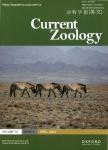Loss of sexual isolation in a hybridizing stickleback species pair
Loss of sexual isolation in a hybridizing stickleback species pair作者机构:Department of Zoology Ecology Evolutionary Biology & Behavior and BEACON Michigan State University East Lansing MIUSA
出 版 物:《Current Zoology》 (动物学报(英文版))
年 卷 期:2013年第59卷第5期
页 面:591-603页
核心收录:
学科分类:0710[理学-生物学] 07[理学] 0905[农学-畜牧学] 0906[农学-兽医学] 09[农学] 0904[农学-植物保护]
基 金:Acknowledgements We thank C. Long and M. Rounds for help with data collection. Thanks to Tom Getty Genevieve Kozak Michael Jennions several anonymous reviewers and the Boughman lab for helping to improve this manuscript. Research was conducted under permits from the Ministry of the Environment BC and approval from University of Wis- consin-Madison Institutional Animal Care and Use Committee. This work was supported by the Emlen Fund from the Zoolo- gy Department of the University of Wisconsin Madison to ACRL and the National Science Foundation to JWB
主 题:Sexual isolation Speciation Hybridization Female preferences Male mating traits Stickleback species pair
摘 要:One approach to understand the importance of reproductive barriers to the speciation process is to study the break- down of barriers between formerly distinct species. One reproductive barrier, sexual isolation, reduces gene flow between species through differences in mate preferences and mating signals and is likely important for species formation and maintenance. We measure sexual isolation in two limnetic-benthic threespine stickleback species pairs (Gasterosteus spp.). One species pair main- tains strong reproductive isolation while the other species pair has recently collapsed into a hybrid swarm. We compare the strength of sexual isolation in the hybridizing pair to the currently isolated pair. We provide the first evidence that sexual isolation has been lost in the hybridizing pair and show furthermore that preferences females have for conspecific mates and the traits they use to distinguish conspecific and heterospecific males contribute to this loss. This work highlights the fragility of reproductive isolation between young species pairs and considers the role of sexual isolation in speciation [Current Zoology 59 (5): 591-603, 2013].



